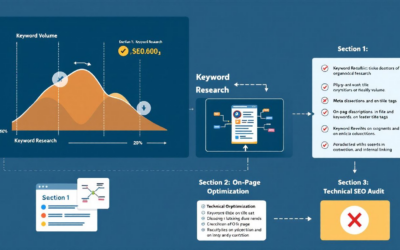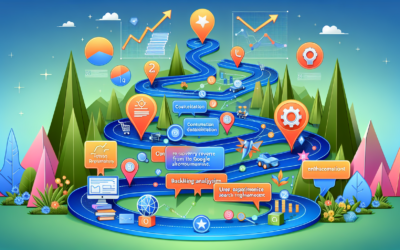A sudden drop in a site’s organic traffic is concerning, and monitoring target keywords is crucial for understanding website performance. Understanding user intent is also essential for optimizing content and improving website traffic, especially in response to Google Algorithm updates. We’ll explore common causes and show you how to diagnose and fix the problem to get your traffic back on track.
Key Takeaways
- Identify causes of traffic drops like search engine algorithm updates, technical issues, content changes, or penalties to take the right action.
- Leverage digital marketing strategies, including SEO tools and AI advancements, to respond to traffic fluctuations and improve overall performance in search rankings.
- Use diagnostic tools like Google Search Console, Google Analytics, and third-party SEO tools to pinpoint traffic drop issues and monitor your site’s organic traffic.
- Implement best practices like improving on-page and technical SEO, and building high-quality backlinks to recover lost traffic.
Understanding the Drop in Organic Traffic
Experiencing a sudden drop in organic traffic can be alarming, but understanding the underlying causes is the first step toward recovery. It’s crucial to approach this systematically, using reliable tools and methods to diagnose the issue accurately.
Start by leveraging Google Search Console and Google Analytics to gather data on your website’s performance. These tools offer invaluable insights into various aspects of your site, from search engine rankings to user behavior. By analyzing this data, you can pinpoint specific areas that may be contributing to the traffic decline. Sudden traffic drops often signal significant changes that need to be addressed, such as Google updates or technical issues, so it’s essential to analyze your data to identify the root causes.
For instance, a sudden drop in search engine rankings could indicate a recent Google algorithm update or changes in user search intent. Regularly monitoring your rankings with a rank tracker can help you stay ahead of such changes and adjust your SEO strategy accordingly.
Additionally, conducting a thorough technical SEO audit is essential. This audit will help you identify and fix issues like broken links, slow page load times, and mobile usability problems, all of which can negatively impact your site’s visibility on search engines. Page speed is a critical factor in on-page optimization, as Google considers it a ranking factor. Poor performance can lead to increased bounce rates and a drop in traffic. Tools like Google Search Console can highlight these technical issues, allowing you to prioritize and address them promptly.
Inbound links also play a significant role in maintaining your search engine rankings. If your site loses inbound links, it can lead to a drop in organic traffic. Use tools like Ahrefs or SEMrush to analyze your backlink profile and identify opportunities to acquire new, high-quality links.
By systematically understanding and addressing the factors contributing to the drop in organic traffic, you can develop a targeted strategy to recover and even improve your website’s performance.
Common Reasons for a Sudden Drop in Organic Traffic

Understanding the reasons behind a sudden drop in organic traffic is the first step to recovery. Common causes include:
- Google algorithm updates
- Technical SEO issues
- Changes or deletions in content
- Manual actions or penalties from Google
- Poor internal linking structure
- Low quality backlinks
If your organic traffic dropped suddenly, it’s crucial to identify and address the issue promptly. Monitoring your site’s organic traffic through tools like Google Search Console is essential for gaining insights into SEO performance and identifying potential issues early.
Each of these factors can significantly impact your website’s traffic if not addressed promptly.
Google Algorithm Updates
Google frequently updates its algorithms to improve user experience by refining how search results are ranked. These updates can lead to significant fluctuations in website traffic, especially if your site isn’t optimized for the changes. Regularly monitoring your web traffic is vital to detect early indications of algorithm updates that might be affecting your site’s performance. Additionally, monitoring your site’s organic traffic through tools like Google Search Console is crucial for gaining insights into your SEO performance and addressing any sudden drops in traffic.
To determine if a Google algorithm update is the cause of your traffic drop, start by checking for recent announcements or indications of updates. Tools like MozCast and SEMrush Sensor are useful for tracking these updates and understanding their impact on your site’s search rankings. Also, SEO experts often use resources like Barry Schwartz’s “Was There A Google Update” to stay informed about ranking changes.
Technical SEO Issues
A drop in organic traffic can often be traced back to technical SEO issues that severely impair your site’s visibility on search engines. These issues can include broken links, slow page load times, and crawl errors, all of which can prevent Google from properly indexing your site. A technical SEO audit can help identify such problems and ensure they are fixed promptly. Monitoring your site’s organic traffic through tools like Google Search Console is crucial for gaining insights into SEO performance and addressing any sudden drops in traffic.
Unattended technical issues can escalate the traffic decline by resulting in a poor user experience and increased bounce rates. Regularly inspect your site for technical problems, such as server downtime or changes in URL structure, to maintain optimal SEO performance. SEO tools like ScreamingFrog are invaluable for auditing and addressing these issues.
Content Changes or Deletions
Drastic changes or deletions in your site’s content can lead to a drop in organic traffic if the updates result in reduced relevance or quality. Google’s web crawlers may visit your site less frequently if there’s a decrease in publishing velocity, leading to a decline in traffic.
Maintaining organic traffic necessitates that your content remains high-quality, relevant, and free of errors or typos. Additionally, monitoring your site’s organic traffic through tools like Google Search Console is crucial for gaining insights into SEO performance and addressing any sudden drops in traffic.
Manual Actions and Penalties
Manual actions and penalties from Google for guideline violations can cause significant drops in organic traffic. Google notifies site owners of these actions via the Manual Actions Report in Google Search Console. Monitoring a site’s organic traffic is crucial for identifying and addressing such issues promptly.
To recover from such penalties, ensure no manual actions have been applied to your site and disavow any toxic backlinks.
Tools to Diagnose Organic Traffic Drops

Possessing the right diagnostic tools is vital when dealing with a sudden drop in organic traffic. Some useful tools for diagnosing and analyzing your website’s traffic include:
- Google Search Console
- Google Analytics
- Ahrefs
- Semrush
Correctly deploying the tracking code is essential for accurate data collection and monitoring website traffic.
Monitoring a site’s organic traffic through these tools is crucial for gaining insights into SEO performance and addressing any issues promptly. Additionally, using the URL Inspection Tool ensures that Google can access and crawl affected pages, which is critical for resolving indexing issues.
These tools can provide valuable insights into what’s going wrong and help you formulate a recovery plan.
Google Search Console
Google Search Console is an indispensable tool for monitoring site performance and identifying issues that can lead to a decline in organic traffic. It helps detect indexing issues, usability problems, and server errors, providing detailed reports that can guide your troubleshooting efforts. Monitoring your site’s organic traffic through Google Search Console is crucial for gaining insights into your SEO performance and addressing any sudden drops in traffic.
A regular check-up of your Google Search Console account allows you to preempt potential problems and keep your site in optimal health.
Google Analytics

Google Analytics offers a deep dive into your website’s traffic data, enabling you to analyze trends and pinpoint the causes of a traffic drop. By examining session data, conversion rates, and changes in traffic sources, you can identify specific issues and address them effectively.
Monitoring your Google Analytics account helps to track traffic flow and pinpoint the moment of sudden traffic loss, crucial for identifying organic downward trends. Additionally, monitoring a site’s organic traffic through tools like Google Search Console provides valuable insights into SEO performance and helps address common issues.
Third-Party SEO Tools
Third-party SEO tools like Ahrefs and Semrush are invaluable for diagnosing traffic declines. These tools can track keyword performance, monitor backlink profiles, and provide insights into competitor activity, helping you understand why your organic traffic has dropped. Monitoring a site’s organic traffic through tools like Google Search Console is crucial for gaining insights into SEO performance and addressing any sudden drops in traffic.
SEMrush and similar tools can assist in tracking competitor keyword rankings and detecting significant changes due to algorithm updates.
Steps to Identify the Root Cause of Traffic Decline

Identifying the root cause of a traffic decline involves a systematic approach. Start by analyzing traffic patterns, reviewing recent changes to your site, and comparing competitor activity. This thorough analysis will help you pinpoint the exact issue and develop a targeted strategy for recovery. Additionally, keeping your content and strategies up to date with current trends is essential to align with Google algorithm updates and social media engagement. Monitoring your site’s organic traffic through tools like Google Search Console is crucial for gaining insights into your SEO performance and addressing any sudden drops in traffic.
Significant changes to a site’s content or structure during a site migration can lead to a drop in organic traffic if not managed correctly. Proper redirection and hygiene checks are necessary to mitigate the potential negative impact on search rankings.
Analyze Traffic Patterns
Analyzing traffic patterns using historical data is crucial for identifying significant deviations and understanding the cause of traffic drops. Look for trends in specific traffic sources, such as a decline in organic search traffic, and segment your data by device type, geography, and landing pages to pinpoint the drop more accurately.
For this analysis, Google Analytics is indispensable as it provides detailed insights into your website’s traffic trends. Additionally, monitoring a site’s organic traffic through tools like Google Search Console is essential for gaining insights into SEO performance and addressing common issues.
Check for Recent Changes
Reviewing recent changes to your site’s structure or SEO strategy can reveal potential causes of traffic decline, such as your site losing links. Changes in URL structure, incorrect 301 redirects, or modifications in link-building techniques can all lead to a drop in traffic.
Consider any changes to your website’s hosting or server environment as well, as they can impact site performance and traffic. Monitoring your site’s organic traffic through tools like Google Search Console is crucial for gaining insights into your SEO performance and identifying any sudden drops or issues.
Compare Competitor Activity
Comparing competitor activity can provide valuable insights into market shifts and help you devise strategies to recover lost traffic. Tools like SEMrush can monitor competitor traffic patterns and identify if they are attracting your audience.
Analyzing competitors’ content strategies can reveal shifts in ranking dynamics, allowing you to adjust your SEO strategy accordingly. Additionally, monitoring your site’s organic traffic through tools like Google Search Console is crucial for gaining insights into your SEO performance and addressing any sudden drops in traffic.
Best Practices for Recovering Lost Organic Traffic

Recovering lost organic traffic involves implementing best practices such as improving on-page SEO, enhancing technical SEO, and building high-quality backlinks. Focusing on content quality is also essential, as it significantly influences engagement metrics and overall website visibility. These strategies can help restore and even boost your website’s traffic, ensuring long-term success. Monitoring a site’s organic traffic through tools like Google Search Console is crucial for identifying issues and measuring the effectiveness of your SEO efforts.
Additionally, it is important to disavow spammy links to maintain a healthy backlink profile and avoid penalties from Google.
Improve On-page SEO
Optimizing on-page SEO elements like meta descriptions and header tags can significantly improve search engine visibility and increase organic traffic. Revising website content to include long-tail keywords and enhancing meta descriptions can drive more clicks from search engine results. Monitoring a site’s organic traffic through tools like Google Search Console is crucial for gaining insights into SEO performance and addressing any sudden drops in traffic.
Implementing structured data markup and optimizing HTML title tags are also effective strategies for improving on-page SEO.
Enhance Technical SEO
Enhancing technical SEO by fixing issues like broken links and slow page load times can improve user experience and search engine rankings. Ensuring mobile-friendliness and improving page loading speed are crucial for maintaining optimal SEO performance. Monitoring a site’s organic traffic through tools like Google Search Console is essential for gaining insights into SEO performance and addressing any sudden drops in traffic.
Tools like ScreamingFrog can help audit and address these technical issues effectively.
Build High-Quality Backlinks
Building high-quality inbound links from authoritative sites is essential for boosting website authority and regaining lost organic traffic, especially when a site loses inbound links. Networking with authoritative websites, leveraging broken backlinks, and developing content partnerships are effective strategies for acquiring valuable backlinks.
Publishing original research can also attract links from other websites seeking to reference your unique insights. Additionally, monitoring a site’s organic traffic through tools like Google Search Console is crucial for gaining insights into SEO performance and addressing any sudden drops in traffic.
Ensure a Mobile-Friendly Website
In today’s digital landscape, having a mobile-friendly website is crucial for maintaining and improving your website traffic. With the majority of users accessing websites through mobile devices, search engines prioritize mobile-friendly websites in their search results. A non-responsive website can lead to a sudden drop in traffic, as it fails to meet the expectations of both users and search engines.
Google Search Console is an invaluable tool for identifying mobile usability issues. By regularly monitoring your site’s performance, you can pinpoint areas that need improvement and take corrective action. A mobile-friendly website should have a responsive design, easy navigation, and fast loading speed to enhance user experience and boost search engine rankings.
To analyze your website’s speed and identify areas for improvement, use Google PageSpeed Insights. This tool provides detailed reports on your site’s performance and offers actionable recommendations to optimize loading times. Ensuring a mobile-friendly website is essential for businesses aiming to attract and retain online customers.
Regularly monitoring your website traffic and analytics can help you identify any mobile-related issues and prevent sudden drops in traffic. By staying proactive and addressing these issues promptly, you can maintain a strong online presence and continue to drive traffic to your site.
Leverage Social Media Presence
A strong social media presence is essential for driving traffic to your website and improving your search engine rankings. Social media platforms offer a unique opportunity to reach a wider audience, increase brand awareness, and drive traffic to your site. By leveraging these platforms effectively, you can enhance your online visibility and attract more visitors.
Social media analytics tools are crucial for tracking your performance and identifying areas for improvement. These tools provide insights into your audience’s behavior, engagement rates, and the effectiveness of your content. By analyzing this data, you can adjust your social media strategy to better meet your audience’s needs and drive more traffic to your website.
Sharing high-quality, engaging content on social media is key to attracting and retaining your audience. By consistently posting valuable content, you can build trust and credibility with your followers, encouraging them to visit your website. Additionally, promoting your website and sharing updates on social media can help drive traffic and improve your search engine rankings.
Social media presence is a key ranking factor, and website owners should prioritize building a strong social media presence to enhance their website’s traffic and search engine rankings. Regularly monitoring social media analytics can help you identify areas for improvement and adjust your strategy to drive more traffic to your website.
Analyze Referral Traffic Sources
Referral traffic is an essential source of traffic for many websites, and analyzing referral traffic sources can help website owners identify areas for improvement. Google Analytics is a powerful tool for tracking referral traffic, identifying top referral sources, and analyzing the quality of referral traffic. By understanding where your traffic is coming from, you can optimize your website to attract more visitors from these sources.
Analyzing referral traffic sources can help you identify potential partners, collaborators, or influencers who can help drive traffic to your website. Building relationships with these referral sources can lead to increased traffic and improved search engine rankings. Additionally, referral traffic data can help you adjust your marketing strategy to focus on high-quality referral sources and improve your website’s overall performance.
Regularly monitoring referral traffic can help you identify sudden drops in traffic and take corrective action to prevent further declines. By staying proactive and addressing any issues promptly, you can maintain a steady flow of referral traffic and continue to grow your online presence.
Referral traffic analysis can also help you identify opportunities to improve your website’s content, user experience, and search engine rankings. By leveraging this data, you can make informed decisions that enhance your website’s performance and drive more traffic to your site.
Monitoring and Maintaining Organic Traffic
Monitoring and maintaining a site’s organic traffic involves regular SEO audits, staying updated with algorithm changes, and using Google Trends. These practices ensure that your website remains optimized and can adapt to changing market trends. Additionally, monitoring a site’s organic traffic through tools like Google Search Console is crucial for gaining insights into SEO performance and addressing any sudden drops in traffic. Regularly checking your website’s analytics can help identify and address technical issues before they lead to significant traffic drops.
Broken internal links can negatively impact SEO performance by disrupting the internal link structure of your website. It is essential to identify and fix these broken links using technical SEO tools to maintain website integrity and ensure proper indexing by search engines.
Regular SEO Audits
Conducting regular SEO audits helps to identify weaknesses in on-page and technical SEO elements, ensuring your website stays optimized for search engines. Auditing backlinks and regularly updating old content can help maintain your site’s relevance and improve its chances of ranking higher. Monitoring a site’s organic traffic through tools like Google Search Console is also crucial, as it provides insights into SEO performance and helps identify and address any sudden drops in traffic.
Stay Updated with Algorithm Changes
Keeping abreast of Google algorithm changes is vital for adapting your SEO strategy and either maintaining or improving organic traffic. Following reputable SEO blogs, forums, and industry newsletters can help you stay informed about major updates and optimize your site accordingly. Additionally, monitoring your site’s organic traffic through tools like Google Search Console is crucial for gaining insights into your SEO performance and addressing any sudden drops in traffic.
Use Google Trends
Google Trends can assist in:
- Identifying seasonal trends
- Identifying popular search terms
- Enabling timely content adjustments
- Enhancing organic traffic
The tool can show spikes in keyword search volumes due to real-world events, assisting in creating relevant and timely content. Additionally, monitoring a site’s organic traffic through tools like Google Search Console is crucial for gaining insights into SEO performance and addressing any sudden drops in traffic.
Use Search Engines to Identify Opportunities
When faced with a drop in organic traffic, it’s essential to use search engines and related tools to identify opportunities for improvement. Google Search Console and Google Analytics are your best allies in this endeavor, providing detailed insights into your website’s performance and highlighting areas that need attention.
Begin by checking your website’s search engine rankings. A rank tracker can help you monitor your rankings over time and spot any sudden changes. If you notice a decline, it could be due to recent modifications on your site, shifts in Google’s algorithm, or changes in user behavior and search intent. Understanding these factors is crucial for developing an effective recovery strategy.
Next, focus on your website’s technical SEO. Conduct a comprehensive technical SEO audit to uncover issues that might be affecting your site’s performance. Look for broken links, slow page load times, and mobile usability problems. Google Search Console is particularly useful for identifying these technical issues, allowing you to prioritize and fix them efficiently.
Inbound links are another critical factor in maintaining strong search engine rankings. If your site loses inbound links, it can significantly impact your organic traffic. Use tools like Ahrefs or SEMrush to analyze your backlink profile and identify opportunities to acquire new, high-quality links. Building a robust backlink profile can help improve your site’s authority and visibility on search engines.
By using search engines to identify opportunities, you can take proactive steps to enhance your website’s performance and recover from a drop in organic traffic. Regularly monitor your site’s performance and adjust your SEO strategy as needed to stay ahead of the competition and maintain steady growth in organic traffic.
Summary
Summarize the key points discussed in the article, emphasizing the importance of diagnosing and addressing the root causes of a traffic drop. Provide a final inspirational note, encouraging readers to implement the strategies discussed and monitor their progress. Additionally, it is crucial to monitor a site’s organic traffic through tools like Google Search Console to gain insights into SEO performance and address any sudden drops effectively.
Frequently Asked Questions
What are the common reasons for a sudden drop in organic traffic?
A sudden drop in organic traffic can be caused by Google algorithm updates, technical SEO issues, changes or deletions in content, and manual actions or penalties from Google. Understanding and aligning with search engine algorithms is crucial, as these updates can significantly impact website traffic. Be sure to check these areas if you experience a decrease in traffic. Additionally, monitoring a site’s organic traffic through tools like Google Search Console is crucial for gaining insights into SEO performance and identifying potential issues early.
Fixing broken links is also an essential part of technical SEO. Broken links can disrupt user experience and negatively impact search engine rankings, so it is important to identify and resolve these issues proactively using tools like broken link checkers and 301 redirects.
What steps should I take to identify the root cause of a traffic decline?
To identify the root cause of a traffic decline, analyze traffic patterns, review recent changes to your site, and compare competitor activity. This will help you understand what may be causing the decline. Additionally, monitoring your site’s organic traffic through tools like Google Search Console is crucial for gaining insights into your SEO performance and addressing any sudden drops in traffic.
How can I maintain and monitor organic traffic?
To maintain and monitor organic traffic, conduct regular SEO audits, stay updated with Google algorithm changes, and use Google Trends to monitor your performance. This will help you keep track of your organic traffic and make necessary adjustments to improve it. Additionally, monitoring a site’s organic traffic through tools like Google Search Console is crucial for gaining insights into SEO performance and addressing any sudden drops in traffic.









